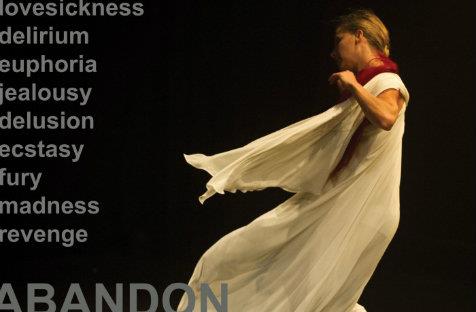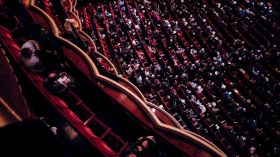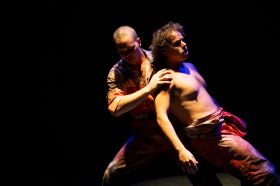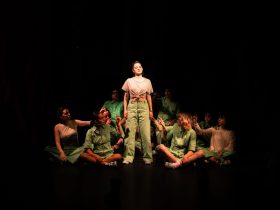The idea of partnering a selection of Handel’s Da Capo Arias performed live on stage with choreographed dance is exciting. And this 67-minute production, directed by the triumvirate of Lindy Hume, Raewyn Hill and James Crabbe – ‘like a dream whose submerged meaning speaks to the dreamer alone,’ – succeeded in capturing the imagination of the audience in Dancenorth’s compact theatre.
Refreshingly, the musicians were anything but note bound. Neither were they stuck behind a music stand. Boundaries between dancer and musician were blurred as the costumed James Crabbe (accordion) and Teije Hylkema (cello) created a seductive spontaneity by wandering through the set, at times chasing the wave of dancers away with their music. (Crabbe’s arrangements are effective.)
Throughout the performance there were lovely directorial touches, for instance when Erynne Mulholland exudes grace after being hoisted into the air by other dancers who are concealed underneath her costume’s voluminous folds; and when the singers Annie Lower, Elizabeth Lewis, Monique Latemore and Christopher Richardson mirror the dancer’s steps. Another moment of wonder is when dancers and soloists huddle together and sing in a cavity of the set’s cardboard wall.
The performance involved risk and generated tension as the choreography and music profitably intersected and the members of the audience held their breath. The potential of such a winning collaboration is massive and ought to be encouraged. Yet the performance was not without teething problems.
The three-sided set of ceiling high cardboard packing boxes by Bruce McKinven is an imaginative concept and its versatility was proven as boxes are taken out of the walls to create windows or ledges enabling the cast to pose on different levels. But the boxes also created a dry acoustic and curtailed resonance.
This impacted negatively on the deeper-voiced Lewis. Lower’s stronger soprano fared well and suitably soared as she channelled the tumultuous Handelian emotional palette. But there were also balancing issues, easy enough to sort, when Crabbe played too vehemently and swamped a singer’s phrases.
The choreography at one stage involved a sequence of forward and backward flurries to mirror the ebb and flow of Handel’s elegant phrases and these created a pleasing light and shade. And there were lovely dancerly solos especially by (Alice Hynde).
But, having admired Dancenorth’s Mass, also choreographed by Hill, it was disappointing that several moves from this previous show, reproduced in this interdisciplinary presentation, seemed jaded and laboured and ill-suited to the music. The use of the dancers’ hair as an expressive device is distracting and came across as derivative.
But, with judicious tweaking of the choreography and adjustment of balances, this is an enthralling, richly-envisioned and visually arresting production that deserves another showing.
Abandon
A Dancenorth collaboration with Opera Queensland
Featuring the music of Handel
School of Arts Theatre, Townsville
24 July – 1 August





